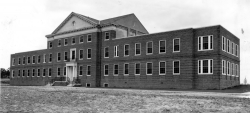Forest Haven
| Forest Haven | |
|---|---|
 | |
| Opened | 1925 |
| Closed | 1991 (as a mental health facility) |
| Current Status | Closed |
| Building Style | Cottage Plan |
| Location | Laurel, MD |
| Alternate Names |
|
History[edit]
Congress built the brick campus in 1925 as a place to exile people classified as "idiots" from the nation's capital and hide them in a rural area, records show. The District of Columbia was feeling political pressure from the then-wealthy Logan Circle neighborhood to close the nearby Washington Home For Colored Idiots.
Some of those who built Forest Haven as a replacement for the Washington Home may have had good intentions. Residents lived in tree-shaded dorms with bucolic names such as Elm or Poplar Cottage. Counselors taught residents to tend crops, milk cows and work in the laundry room. Forest haven was initialy considered a "progressive" institution by the standards of the time, there were baseball fields, a pool and gymnasium. But as the years went on and the district suffered from financial crises,and by the 1960's virtualy all recreation and education stopped. Following worsening conditions and a barrarage of abuse allegations, in 1978 a civil lawsuit was filed by parents of many children at forest haven, this massive lawsuit eventualy led to many patients being transfered to group homes in the area, where they were able to recive more attentative care.
While initialy meant for children with serious disabilities (called "retarded" in the 20th century) Forest haven started to reflect a story all too common in Mental institutions, in the mid 20th century especialy the institution was used more and more as a convienient dumping grounds, Forest Haven became the home to many people who had relativley minor learning disabilities such as Dyslexia and physical disabilities such as blindness. Children who did not speak English as their native language were also sometimes dumped here, many of these people could take care of themselves and only needed help from parents however due to social stigmas in the 60's many of these people where dumped in these facilities. In 1974 twenty perfectly functional orphans were also sent to Forest Haven purley because the orphanage they were housed in had closed. Forest haven was not just overcrowded but also understaffed, with up to 100 open positions, these positions were not filled mostly due to a lack of funds and inability to pay a large number of staff.:Like many other institutions throughout the country Forest Havens problems came from stigmitization of mental disabilities (wich led to many people dumping their disabled children and overcrowding at these institutions) and decades of state budget cuts (wich led to these institutons not being able to hire addaquite staff or even make needed repairs to buildings).
The residents' bodies and bank accounts were abused. A district court in September 1981 convicted a Forest Haven worker of stealing $40,000 from residents' savings accounts. Staff members locked dozens of residents, naked except for adult-sized diapers, in rooms stripped of furniture other than wooden benches, according to the 1976 lawsuit. Some residents were tied to beds and chairs, and some choked to death on food the staff fed to them while they were restrained. A doctor serving the institution was ruled to be "professionally incompetent" by the Maryland Commission on Medical Discipline in 1988. [1]
The facility was closed on October, 14th, 1991. The closure was enforced through a federal court order after years of allegations of abuse, medical incompetence, and several deaths of aspriration pneumea. The last resident of forest haven was relocated on september, 29th, 1991.
Cemetery[edit]
When the residents died, the staff dumped them into unmarked graves in a field near the administration building. Nothing told passers-by that there were bodies beneath the grass from the first burial in 1928 until 1982, when families raised a single gray monument as a memorial to the 389 dead. Due to poor planning and hasty burial some grave sights have been disturbed by erosion from the Little Patuxent River.